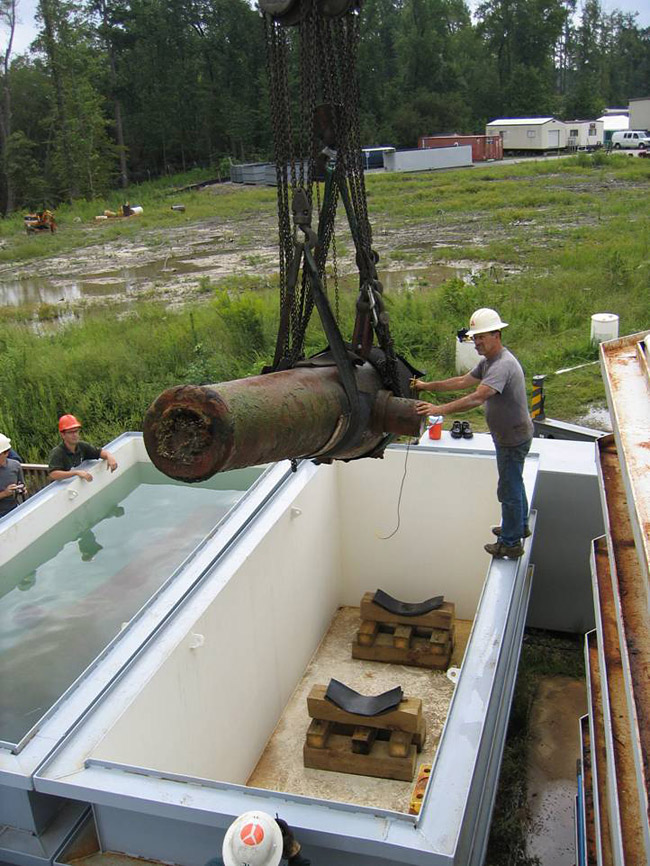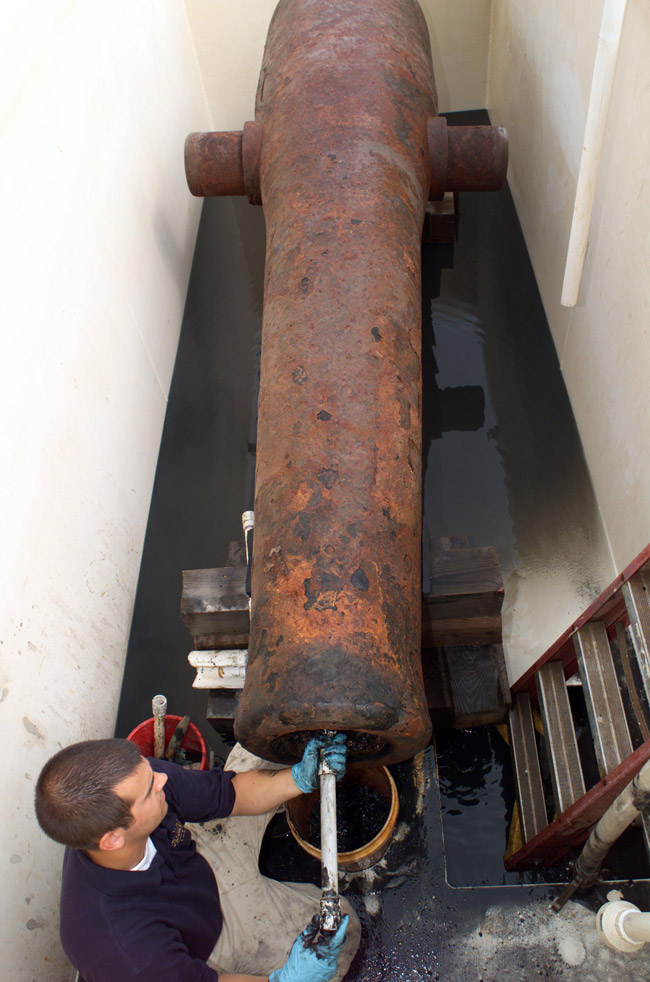The Monitor's Cannons
The Monitor had two cannons that could fire solid shots weighing 140 pounds. These cannons helped the Monitor persevere over the CSS Virginia during the Battle of Hampton Roads in 1862. The cannons were recovered in 2002 and are currently undergoing conservation at The Mariners' Museum in Virginia.
Monitor's Cannon

Conservators place the Monitor's cannons in a conservation tank at The Mariners' Museum.
Cannon Excavation

Cannon excavations took place during the summer of 2005. Excavation and examination of the cannons helped to solve the myth of "the cat in the cannon." Image courtesy of The Mariners' Museum.
High resolution available. (1.01MB, 1987x3000).
The Monitor had two XI-inch Dahlgren, smooth-bore cannons that weighed nearly nine tons each. They were originally cast in New York and installed on the Monitor in early 1862. Although most warships had many more cannons, the Monitor's rotating gun turret made it possible for only two cannons to be capable of firing in multiple directions. These cannons were capable of firing solid shots weighing 140 pounds with 15 pounds of gunpowder.
After the Battle of Hampton Roads, one cannon was engraved with the words "Worden Monitor & Merrimac" (in honor of the Monitor's captain, John Worden), and the other was engraved with "Ericsson Monitor & Merrimac" (in honor of the ship's designer, John Ericsson).
Historic Reference
Francis Butts, crewman on the Monitor, wrote about his time on the ship and is responsible for one of the most popular legends in the history of the Monitor. In his written account, Butts claimed that during the night the ironclad sank, he shoved his coat and boots in one cannon and a cat in the other.
His account has led many to ask if there is a cat in one of the Monitor's cannon barrels. However, since no other crew members ever mentioned a cat on board the ship in their writings, Butts' claims have been met with some skepticism.
Recent research has shown with certainty that neither cannon was "loaded" when the ship sank and no trace of organic material (i.e., a cat) has been found, suggesting that Butts stretched the truth in giving his accounts on the Monitor.
Francis Butts presented his account of the Battle of Hampton Roads and the sinking of the Monitor to the Rhode Island Soldiers and Sailors Society. Excerpts from his story were later printed in Century Magazine in 1885.
Artifact Recovery
After the turret was raised in 2002, conservators began the long process of excavating the fragile cannons from the turret and stabilizing them. The cannons were removed from the turret in 2004 and placed in conservation tanks. They are currently undergoing an extended soaking process to remove chlorides from the iron. This process will take approximately five years, after which the cannons will be on display in the museum.
- Location: The Mariners' Museum, Newport News, Virginia
- Recovery: 2002, after a 45-day recovery expedition
- Notable Features: After the Battle of Hampton Roads, one cannon was engraved with the words "Worden Monitor & Merrimac" (in honor of the Monitor's captain, John Worden), and the other was engraved with "Ericsson Monitor & Merrimac" (in honor of the ship's designer, John Ericsson).
Related Web Sites:
Monitor National Marine Sanctuary
National Marine Sanctuary Program
The Monitor Center at The Mariners' Museum
Works Consulted:
Monitor National Marine Sanctuary. (1994). A look at the Monitor National Marine Sanctuary: Past, Present and Future.
Monitor National Marine Sanctuary. (2005). Monitor National Marine Sanctuary factsheet.
(top)

 George S. Geer Letters: Life Aboard an Ironclad
George S. Geer Letters: Life Aboard an Ironclad The Monitor's Rotating Gun Turret
The Monitor's Rotating Gun Turret The Monitor's Cannons
The Monitor's Cannons The Monitor's Anchor
The Monitor's Anchor The Monitor's Propeller
The Monitor's Propeller The Red Lantern
The Red Lantern Silverware from the Monitor
Silverware from the Monitor The Monitor's Engine and Register
The Monitor's Engine and Register Condiments and Bottles
Condiments and Bottles Monitor Photomosaics
Monitor Photomosaics